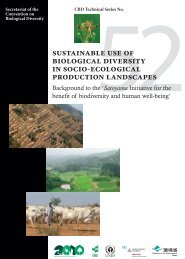INDIAN SCIENCE CONGRESS - India Environment Portal
INDIAN SCIENCE CONGRESS - India Environment Portal
INDIAN SCIENCE CONGRESS - India Environment Portal
You also want an ePaper? Increase the reach of your titles
YUMPU automatically turns print PDFs into web optimized ePapers that Google loves.
Section XIV : Plant Sciences 13<br />
by which they can be easily identified. But there is hardly any such feature that<br />
separates M. esculanta and M. deliciosa, so that these have been often regarded<br />
as a single species. However, the data of Gessner et al. (1981) on allelic variation<br />
and segregation in these two species clearly points that these are two different<br />
taxa. This data plus data of Hervey et. al. (1978) suggested that the potential for<br />
gene exchange may be used as a means of discriminating taxa within the genus<br />
Morechella. Therefore, similar studies are needed on the six traditional species and<br />
that are they considered variants or have been described as new species in recent<br />
times (M. rotunda, M. tibelica, M. umbrina and M. simlensis sp. nov.).<br />
The polymorphism and genetic diversity in the species Morchella was<br />
assessed at molecular level. The phlylogenetic tree (dendrogram) generated was<br />
based on the data resulting from RAPD analysis. At 64% similarity coefficients, all<br />
seven species were separated in seven different clusters. The resulting dendrogram<br />
clustered Morchella species into two major groups; A and B at 15% similarity level<br />
which are further divided into different sub-groups. The phylogenetic tree suggested<br />
that the black morels –M. angusticeps, and M. conica (Group A) and yellow<br />
morels –M. esculenta, M. deliciosa and M. crassipes (Group B) have been<br />
reported to be separate taxonomic groups and were distantly related. The other two<br />
species, M. tibelica and M. simlensis sp. nov. have also been categorized to these<br />
respective groups. M. simlensis sp. no. has been more conspecific to yellow morels<br />
(28% similarity level) and M. tibelica showed similarity to the black morels (24%<br />
similarity level) There has been high degree of conspecific variability needs to be<br />
checked between yellow morels i. e. yellow morels have been very less variable<br />
intra specifically but black morels demonstrated high intra specific variability.<br />
Similar studies as on morels were then extended to all the prominent nonconventional<br />
edible mushrooms of the N. W. Himalayas. The studies have been<br />
conducted on their taxonomy, ecology, physiology and nutritional requirements,<br />
ethnic uses and analysis of nutritive components. (Sharma, 1993). Helvella crispa,<br />
Gyromitra esculenta among members of Ascomycotina, Lactarius delicious, L.<br />
sanguifluus, Macrolepiota procera and Russula brevipes among gilled members<br />
and Boletus edulis, B. erythropus, B. hoarkii, Cantharellus cibarius, Hydnum<br />
repandum, Ramaria botrytoides and Sparassis crispa among the non gilled<br />
members of Basdiomycotina.<br />
It has been observed that the protein values in these edible mushrooms are<br />
higher than those reported for various vegetables. The fibre contents are also
















